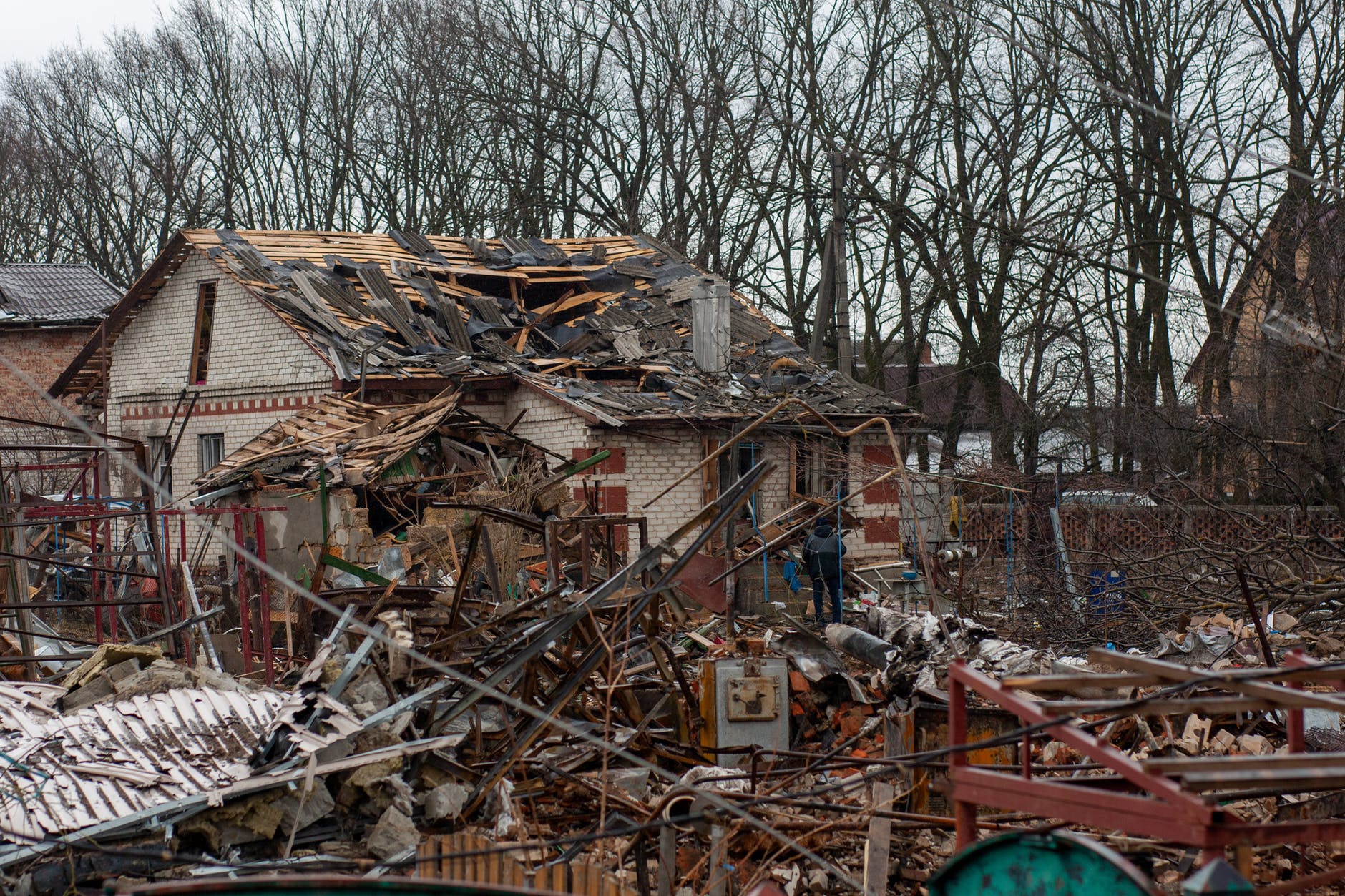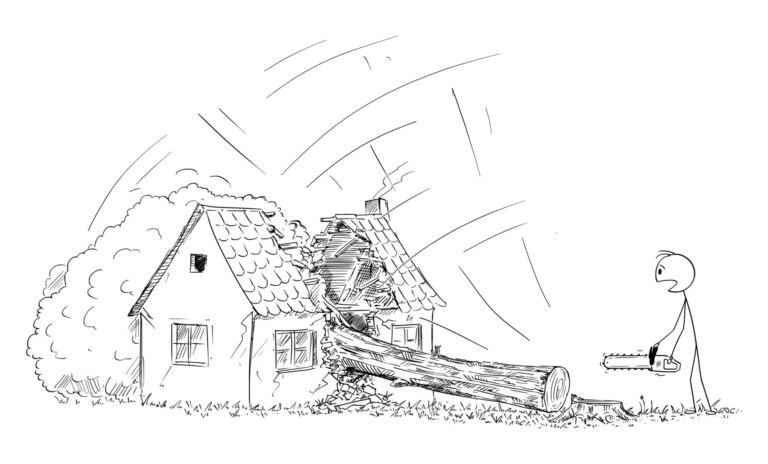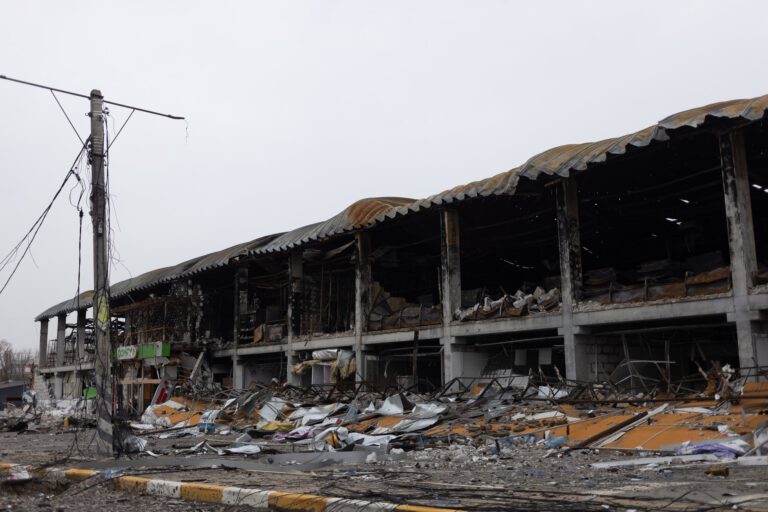Why Home Insurance Is Critical for Your Financial Wellbeing
Six short feet. That’s how close Bruce Ritchie came to dying one October morning two years ago.
Bruce and his wife Marilyn had arrived at their daughter’s Georgetown, Ont., house in the wee hours of the morning, after a frantic call from their son-in-law, Pete. Their very pregnant daughter Allison had gone into labour and she and Pete needed someone to look after their sleeping first-born son, Trenton. Bruce and Marilyn were happy to oblige and quickly drove the 15 km from Acton to Georgetown to see their daughter off to the hospital. On the way back, Bruce decided to pick up some Egg McMuffins as a breakfast surprise for his grandson. He was just unpacking the still-steaming sandwiches when he heard a thunderous noise.
Glancing out the window he could see a massive tractor-trailer heading directly towards the house. He froze. Seconds later the truck sped past the window, clipped the neighbour’s car, and plowed right through the garage before coming to rest in two deep ruts torn into the soft earth of the backyard.
Snapping to attention, Bruce grabbed his wife and grandson and rushed them out of the house and as far from the truck as possible. “I didn’t know if the truck would burst into flames,” he recalls. After a few minutes he ran to the back of the house to check on the driver. “He just kept repeating how he’d lost control.”
The rest of the day was spent with paramedics, fire crews and the police. The truck’s content—raw salt—was removed one gallon at a time as water was pumped into the container and saline pumped out. It wasn’t until nightfall that a 60-ton crane finally lifted the massive truck out of the backyard and onto a flatbed tow truck.
Pete and Allison (whose names we’ve changed to protect their privacy) finally made it home later that day—it turned out Allison had gone into false labour. They were greeted by police tape, people armed with clipboards and dozens of workers trying to remove the truck from their backyard. Once he’d recovered from the shock, the inevitable question popped into Pete’s mind: “Does my insurance cover this?” The answer seemed obvious. A truck had destroyed their garage. They were not at fault. They had an insurance policy and always made regular payments. Of course, this would be covered.
Pete’s initial call to his insurance company left him feeling at ease. The adjuster came within hours, took measurements and made notes, and assured him he would be compensated for his loss. But the hopes raised by the adjuster were false. It turned out that city bylaws had changed since the garage was built, so the replacement garage would have to be set further back from the property line, which meant moving the foundation. Pete needed a special insurance rider to cover that. A rider he didn’t have.
It’s fair to say that most of us couldn’t say with absolute certainty whether or not we’d be covered if our garage was flattened by a runaway truck. Nor do most of us know whether we’d be covered in the event of an earthquake, such as the tremor that recently shook up Ottawa, or flooding, like the Red River overflow that destroyed homes in southern Manitoba, or even a forest fire, like the Greer Creek fires in central interior B.C. which threatened dozens of homes this summer. Reading your policy (to the point where you really understand it) is about as much fun as getting a root canal, and all those possible disasters seem so abstract, so improbable. Until, of course, they happen. Then a single word in your policy can mean the difference between moving on and rebuilding or financial ruin.
If you worry that you might not have the coverage you should, we can help. Read on to find out exactly what you need—and how to get it without paying too much.
What kind of policy should I get?
Generally speaking, there are three types of home insurance coverage—basic, broad (aka: standard) and comprehensive—each with progressively escalating levels of coverage and cost.
Basic coverage is the cheapest, but it is not typically used by homeowners because it only protects the building and not its contents, explains John Thorpe, an independent broker with Utter/Morris Brokers. The next level, broad coverage, only covers you for specific threats that are listed in your insurance document (called “named perils”). If it doesn’t specifically say in your policy that you’re covered for smoke damage, for instance, then you’re not. The third and most popular option is comprehensive. With this coverage, you are covered from all risks except those specifically listed as “exclusions”. This sounds like iron-clad protection—until you see the list of exclusions, which is as long as your arm and often includes the very risks that give you nightmares. Typical exclusions include flooding, damage from water seepage, damage from earthquake, and damage from snow or landslides, among others.
Still, if you’re like most homeowners, a comprehensive policy offers the best protection for the money. That’s because the savings you get by choosing basic or broad coverage are small compared to the level of coverage you lose by downgrading your protection.
How much should I insure my house for?
Insuring your home is much simpler than it used to be. Years ago you would have had to declare the value of your property and contents. Appraisals would have been conducted and estimates created. These days, most companies use a digitized calculator to determine the proper rebuild cost of your home for you. They then typically provide you with what’s called “guaranteed replacement cost” insurance, explains Doug Poole, an independent broker with Hugh Wood Canada. “This means if the calculator is wrong and it costs more to rebuild your house, the insurance company will pay the extra cost.”
Your premium will depend on what replacement cost the insurance company comes up with. A lower replacement cost means lower premiums, but don’t be tempted to push for an unrealistically low figure. “Under-insuring, if deliberate, can void your policy,” says Poole.
What about my stuff?
Most policies not only cover your house but your belongings as well. So-called “contents coverage” insures your clothes, electronics, appliances, furniture and other possessions against theft or damage. Most policies even cover you when you’re on holiday or out in your car. So you can make a claim if your camera is stolen from your hotel room or your laptop is stolen from the back seat while your car was parked at the mall.
The maximum claim limit for the contents of your home is listed on your policy. It’s typically 70% to 80% of your home’s replacement cost. For example, if you have a $300,000 home, you could have as much as $240,000 in coverage for your belongings. If your policy uses actual cash value calculations—as older policies do—you will be able to claim the value of those items in cash, minus any depreciation. For instance, if a $4,000 big-screen plasma TV was stolen, you would get a cheque for $2,048, based on three years of depreciation. On the other hand, if your policy uses replacement value for contents, as most newer policies do, then you must replace your belongings with equivalent replacements yourself, then submit the receipts to get reimbursed. In most cases, replacement cost is the better value—it’s like getting new for old, says Poole.
Keep in mind, however, that in either case, most policies include “special limits” that cap your losses for particular items or types of items, including collectibles, jewelry, art and sports equipment. For example, if someone stole your $2,000 road bike, you may only receive $300 even if your claim limit was not yet reached.
What extra insurance should I buy?
Many of the risks that your policy doesn’t cover are dangers that are best left uninsured, either because you can prevent the damage through proper maintenance of your home, or because the cost of the extra premiums isn’t worth the extra coverage. But there are some cases where it’s worth taking out extra insurance in the form of “riders” to complement your main policy.
Earthquake insurance is one such example, depending on where you live. Such insurance is not included in a comprehensive policy, but a homeowner in Ontario could add this rider for roughly 50 cents per $1,000 of coverage, explains Gilles Gratton, spokesperson for Intact. For instance, a home with a replacement value of $300,000 and maximum contents coverage of $100,000 would require an additional $200 per year in premiums.
But read the fine print. Earthquake insurance only covers damage caused by the earthquake itself—fire and explosions resulting from an earthquake are already covered under an “all risks” policy. Also, earthquake insurance has a much higher deductible than regular home insurance, so claiming damage from an earthquake requires a significant loss. Still, homeowners in quake-prone regions, such as parts of Quebec (especially around Montreal), the Ottawa Valley and B.C, should look into the coverage, according to the Insurance Bureau of Canada.
Another rider that you might want to consider is a bylaw rider. This covers the situation that Pete and Allison found themselves in, where they couldn’t replace their existing garage without moving the foundation because city bylaws had changed. These riders cover all such situations where you can’t just replace the original structure due to bylaw changes. They are recommended if your home was built more than 20 years ago.
Perhaps the most common—and important—rider to add is sewer back-up. According to insurance industry statistics, water damage accounts for 40% to 50% of all claim costs. This is often because today’s basements are no longer unfinished concrete storage areas: they’re customized workout rooms, home theatres, and second kitchens. A basement flood in a space that has been upgraded with carpeting, furnishings and electronics can push a claim from $5,000 to $50,000 or much higher. If your basement is unfinished, you may not want to bother, but if it is, a sewer backup rider is highly recommended.
If you live on a flood plain, however, you may be out of luck. The premiums in such areas will be exorbitant if you can get the rider at all. You should just consider this the insurance industry’s way of saying “don’t develop your basement,” says Thorpe.
What can go wrong?
Even if you have diligently added all the right riders, you still have to watch out for exclusions that can render your coverage null and void, just when you need it most.
Many homeowners have been tripped up by the vacancy exclusion, for instance, which is found in most insurance policies. This states that if you vacate your home for more than 30 consecutive days your home insurance is no longer valid and any loss resulting from an insurable event will not be covered.
Theresa Marche and Gary Fitzgerald of Sydney, N.S., learned that lesson the hard way when they left their home to find work in Vancouver. Before they left, they dutifully notified their insurance agent that they were renting out their home. For two months the house sat empty as Theresa prepped the two apartments and tried to find suitable tenants. Finally, she allowed Gary’s brother and his family to move into the Cape Breton clapboard house. A couple of months later, Theresa got a call from a friend: there had been a fire and much of her home had been burnt to a crisp.
Her insurance company denied the claim, saying that Theresa had breached her contract when she did not disclose that the property had sat vacant for two months before Gary’s brother moved in. Theresa went to trial and fought the case all the way to the Supreme Court. While the court found that Theresa’s actions were legally a breach of contract, the judges ruled in her favour, arguing that despite being in breach, the vacancy was in no way related to the fire. The insurance company had to pay. “We won, but we lost,” says Theresa. Most of the settlement went to legal fees and clean-up costs. After seven years of fighting, the house, which had been left abandoned after the fire, had to be torn down.
Snowbirds and homeowners with apartments (either in their own home or in an investment property) should be particularly mindful of this exclusion. If a property is left empty for more than 30 days, it will only be covered by the home insurance policy if you can document that a reliable person was either living in the home or checking the property every four days.
What if my claim is denied?
It’s comforting to think that making an insurance claim is always a black-and-white affair. After all, you either have the coverage you needed or you don’t, right? Unfortunately, however, many homeowners run into shades of grey. Sometimes your insurance company will swoop in and make everything alright, just like they do in the commercials. But other times, they’ll fight you every step of the way.
That was Pete’s experience when he tried to make a claim for his garage. Because the garage foundation had to be moved, his insurance company offered him just $6,000 towards the $30,000 cost of rebuilding. While he accepted that he would have to pay some of the cost of complying with the new bylaw himself, he didn’t think compensation of $6,000 was anywhere near enough, especially given that there was a guaranteed replacement cost clause in his policy.
Pete did some digging and found out that his insurance company also held the policy for the trucking company that owned the tractor-trailer that destroyed his garage. He felt the insurance company had a conflict of interest, but after 12 months of phone calls, faxes, emails and letters he was getting nowhere. That’s when he packed up his one-year-old and three-year-old and marched down to the company’s offices. “The only reason why I got in the building,” says Pete, “is because of the stroller. I didn’t know you weren’t allowed to see the insurance rep face to face, and the person who held open the door must have thought I was coming to visit an employee.”
Once inside, security threatened to throw him out. But holding his kids tightly, Pete stood his ground. It worked. He left with a cheque for $15,000. A few days later he received another cheque for $3,000 to cover the loss of his garage’s contents. “It blows my mind,” he says, “that such a clear-cut case would take so long, and cause so much deceit.”
This brings us to our final piece of advice: be prepared to prove your case if you have to. Get your agent to explain your policy clearly, so you really understand your coverage, and how to ensure you don’t accidentally violate the terms. Ask lots of questions about what can go wrong and when your coverage could be denied, and keep a record of what you’re told. “Now I know,” Pete says. Insurance companies can be your best friend if you’re lucky—but just in case, “document everything and anything, and keep all your receipts.”







